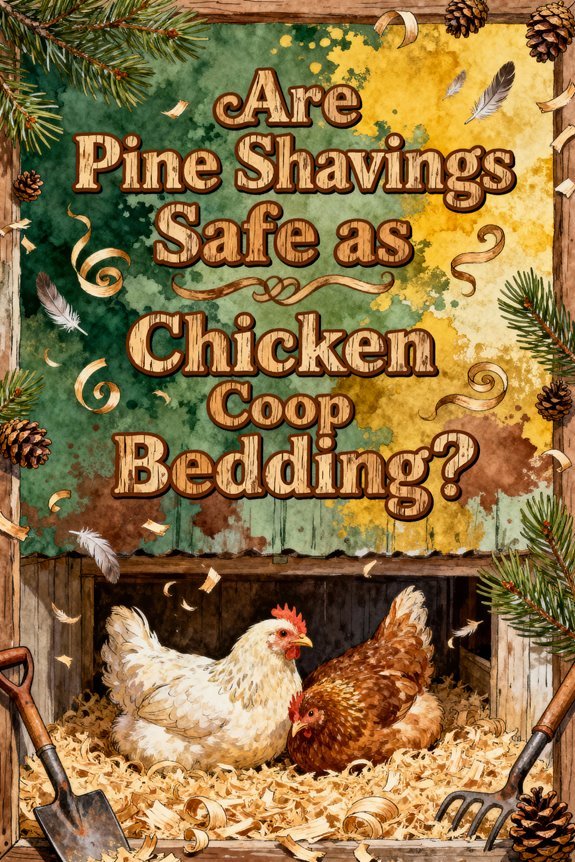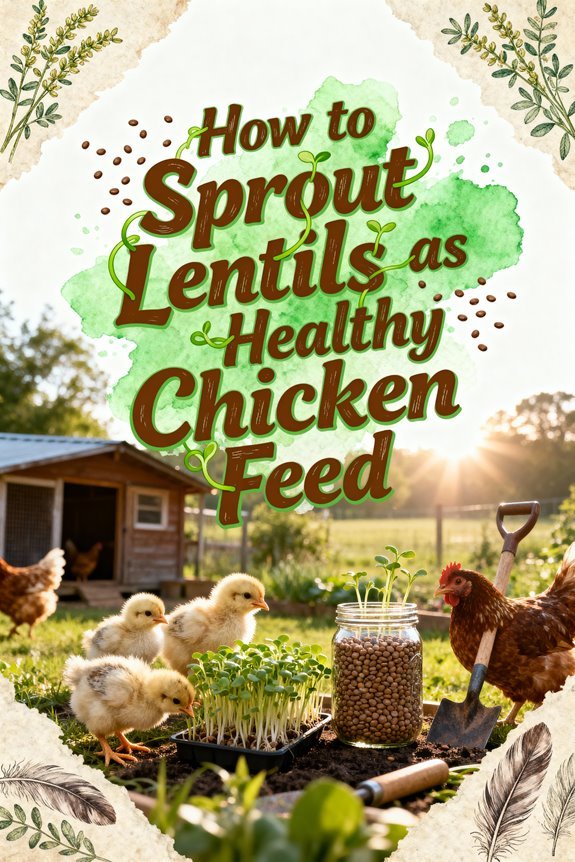Are Pine Shavings Safe as Chicken Coop Bedding?
You can safely use pine shavings in your chicken coop when you select kiln-dried, dust-extracted varieties and maintain proper ventilation. While pine contains natural compounds like abietic acid and terpenes that could pose respiratory risks, proper processing at 600°F eliminates most harmful substances. Monitor your flock for signs of respiratory distress such as wheezing or nasal discharge. Understanding the key factors in pine shaving selection and management guarantees your chickens’ health and comfort.
Understanding the Pine Shavings Controversy
While pine shavings remain a popular bedding choice for chicken coops, mounting scientific evidence has revealed significant health concerns that challenge their widespread use. At the heart of this debate overview are the respiratory risks posed by abietic acid and terpene hydrocarbons released from pine materials, particularly in enclosed spaces.
The shavings criticism centers on two main issues: respiratory hazards and potential toxicity. Pine shavings generate harmful dust particles that can trigger breathing problems in chickens, while natural toxins from resins and oils stress their liver function. The broiler industry’s use misleadingly suggests safety since these chickens are typically processed before long-term effects manifest. Even with processing improvements like kiln-drying and dust extraction, these materials still present notable health risks. You’ll need to weigh these concerns against pine’s practical benefits of absorbency and odor control when choosing your coop bedding.
Natural Chemical Compounds in Pine
Although pine shavings serve as popular chicken coop bedding, their chemical composition reveals a complex matrix of natural compounds that directly impact their performance and safety. The pine chemical composition primarily consists of cellulose, hemicellulose, and lignin, along with valuable compounds like turpentine, rosin, and tall oil fatty acids. As the kraft process dominates industrial pine processing, accounting for 62% of production methods, these natural compounds are efficiently extracted while maintaining their beneficial properties.
You’ll find that pine naturally emits volatile compounds, including monoterpenes such as alpha- and beta-pinene, typically at concentrations around 172 ppb under controlled conditions. These compounds contribute to pine’s natural antimicrobial and antifungal properties. While some worry about these emissions, research shows that pine’s volatile organic compounds (VOCs) at normal levels don’t cause significant irritation in healthy environments. The chemical structure of pine actually offers beneficial properties for bedding, including natural odor control and biological defense mechanisms. Unlike cedar shavings, pine bedding provides these antimicrobial benefits without posing toxic risks to chickens.
Benefits of Using Pine Shavings
The natural chemical properties of pine shavings translate into numerous practical benefits for chicken coop bedding. In this benefits overview, you’ll find that pine shavings excel at moisture control and odor reduction through their moderate absorbency, which helps prevent bacterial growth and ammonia buildup. Their insulating properties regulate coop temperatures, particularly essential during cold seasons. Pine shavings create a cozy and comfortable environment that naturally encourages chickens’ normal behaviors.
From a bedding advantages perspective, you’ll appreciate pine shavings’ cost-effectiveness and widespread availability, making them a practical choice for routine maintenance. They’re lightweight for easy handling and storage, while offering excellent compostability. When you’re done with the bedding, it breaks down efficiently into nutrient-rich garden compost. The material’s natural ability to combat odors and maintain air quality creates a healthier environment for your flock.
Health Risks and Safety Concerns
Despite their popular use, pine shavings present significant health risks that you’ll need to carefully consider before choosing them as chicken coop bedding. The abietic acid and terpene hydrocarbons in pine can cause severe respiratory risks, from mild irritation to chronic lung damage in your chickens. You’ll also face toxicity concerns, as these compounds may impair your flock’s liver function and immune system over time.
The dusty nature of pine shavings compounds these issues, as the fine particles contain carcinogenic substances that your chickens can easily inhale. When moisture is present, pine bedding becomes an ideal environment for bacterial and fungal growth, potentially leading to infections. While research specifically on chickens is limited, evidence from mammalian studies strongly suggests these health risks warrant serious consideration. Consider using shredded paper instead, as it provides a safer alternative for brooding chicks while being more cost-effective.
Dust Management and Ventilation Requirements
Properly managing ventilation becomes critical when using pine shavings as coop bedding, since adequate airflow helps control dust while preventing excess moisture buildup. You’ll need to position vents high above your chickens’ heads and establish cross-ventilation using openings on opposite walls to minimize dust accumulation. Stale toxic air can lead to respiratory issues in chickens if proper ventilation is not maintained.
Your ventilation strategies should adapt seasonally – aim for 0.9 square feet of ventilation per chicken during cold weather, increasing this during warmer months. Place roosting bars strategically below vents to guarantee effective air circulation at bird level. Using dust-extracted shavings is essential for maintaining good respiratory health in your flock. Cover all openings with hardware cloth to maintain security while preserving airflow. You’ll know your ventilation is insufficient if you notice excessive dust, dampness under bedding, or chickens showing signs of heat stress through panting. Regular monitoring helps you adjust ventilation to maintain ideal conditions.
Alternative Bedding Materials Worth Considering
While pine shavings remain popular, several alternative bedding materials offer unique advantages for your chicken coop. Hemp bedding stands out as a premium natural fiber option, boasting superior absorbency and natural antibacterial properties that keep your nesting boxes hygienic. You’ll find sand particularly effective in warmer climates, providing excellent dust bathing opportunities while maintaining low pathogen levels. Regular cleaning and removing droppings helps maintain proper coop hygiene.
For an eco-friendly approach, consider recycled paper or aspen shavings, which produce less dust than traditional wood materials. Straw can work well if you’re seeking a readily available alternative bedding, though you’ll need to monitor it closely for moisture and pest issues. The hollow stems of straw provide excellent insulation during colder months. Each option presents distinct benefits, from hemp’s superior moisture control to sand’s durability, allowing you to choose based on your specific climate and maintenance preferences.
Best Practices for Pine Shaving Usage
To maximize the benefits of pine shavings in your chicken coop, selecting kiln-dried, chemical-free bedding material serves as your foundation for success. You’ll need to guarantee your bedding types are processed at temperatures around 600°F to eliminate harmful pathogens and mold spores. Choose low-dust or dust-free varieties to protect your flock’s respiratory health.
Maintain coop cleanliness by replacing bedding before it becomes wet or moldy, as damp conditions can promote bacterial growth. When implementing the deep litter method, regularly turn the shavings and monitor moisture levels. Our 100% natural pine shavings are completely biodegradable and safe for composting once used. Don’t use pine shavings in outdoor runs where they’re exposed to rain and wind. Instead, limit their use to controlled, indoor environments where they’ll maintain their absorbent properties and provide effective insulation.
Processing Methods and Quality Standards
Since pine shavings require careful processing to confirm safety, manufacturers employ kiln-drying techniques at controlled temperatures to eliminate harmful compounds and reduce moisture content. This processing technique removes abietic acid and terpene hydrocarbons that could harm your chickens’ respiratory health. Adding dried herbs to pine shavings can provide natural pest control benefits while maintaining bedding freshness.
Quality assurance standards mandate pine shavings to maintain low moisture levels, minimal dust content, and consistent particle size. You’ll want to look for certifications indicating proper kiln-drying and testing for volatile organic compounds (VOCs). The shavings should be screened to remove fine dust particles and any sharp debris that could injure your birds. For best safety, avoid using shavings from aromatic woods like cedar or black walnut, and verify your bedding comes from manufacturers who regularly test their products for toxicity levels. Regular application of agricultural lime can help neutralize ammonia odors and maintain optimal pH levels in your pine shaving bedding. The ideal ratio is four parts pine shavings to one part chicken waste to ensure proper composting and odor control.
Signs of Respiratory Distress in Chickens
Maintaining proper bedding conditions helps prevent respiratory issues in your flock, but you’ll need to monitor your chickens for signs of distress regardless of precautions. Watch for early warning signs like increased sneezing frequency, wheezing sounds, and discharge color variations from clear to purulent. As respiratory infection progresses, you’ll notice crust formation around nostrils and dirty wing feathers from eye rubbing. Remember that unlike humans, chickens don’t get colds, so any respiratory symptoms should be taken seriously.
Severe symptoms include comb discoloration turning blue or purple, open mouth breathing, and facial swelling. In hot weather, proper ventilation is crucial to prevent respiratory distress from heat and humidity buildup. Pay attention to lethargy indicators such as reduced appetite and egg production. Different diseases present unique combinations of symptoms – from Chronic Respiratory Disease’s gurgling sounds to Infectious Coryza’s foul-smelling discharge. Listen for rattling breath sounds and observe any head-shaking behaviors that might signal developing problems. Carefully inspect chickens showing reduced activity since blood-feeding mites can cause anemia and weaken their immune systems.
Making an Informed Bedding Choice
Many poultry keepers face difficult trade-offs when considering pine shavings as coop bedding. While pine shavings offer excellent absorbency and insulation for chicken comfort, they also present health risks from toxic compounds and dust. You’ll need to weigh these factors carefully against your specific needs.
If you choose pine shavings, opt for kiln-dried or dust-free varieties to minimize respiratory impacts. You can also consider mixing bedding types, such as combining pine with straw or hemp for enhanced insulation. For sensitive birds or chicks, aspen shavings or sand provide safer alternatives without compromising absorption. Larger flake shavings provide better airflow and help prevent matting issues in the coop.
Unlike rice hulls, which have low moisture absorption, pine shavings excel at keeping coops dry and comfortable. The deep litter method can help generate natural warmth when using pine shavings during winter months. Whatever bedding you select, maintain proper ventilation and implement regular replacement schedules. Don’t use treated pine products, and monitor your flock for signs of respiratory distress when introducing new bedding materials.


